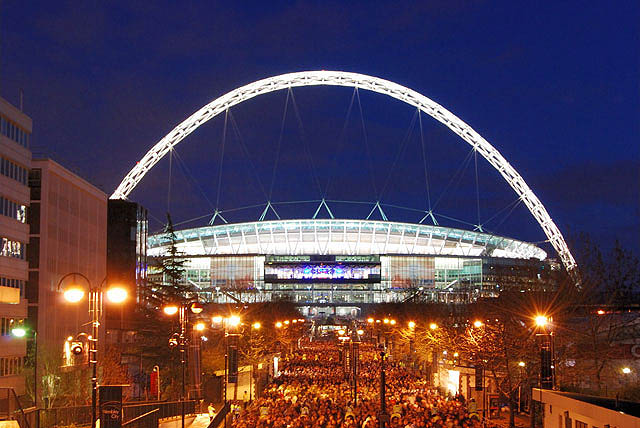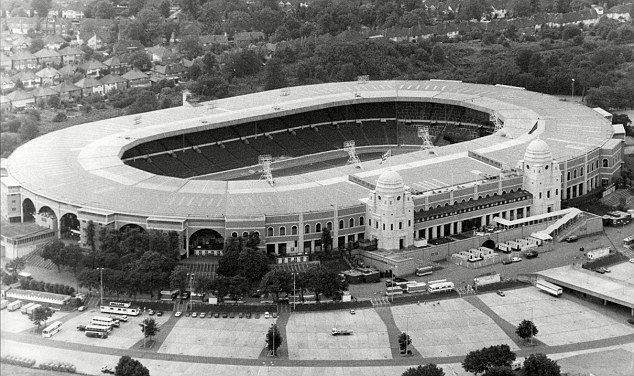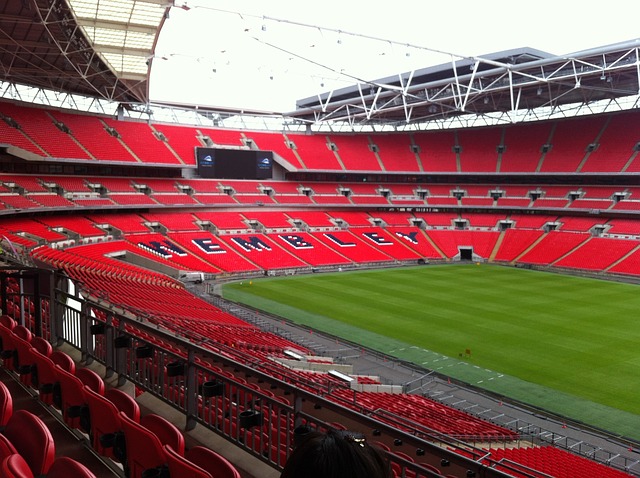Wembley Stadium
Contents |
[edit] Introduction
Wembley Stadium is the largest stadium in the UK and the second-largest in Europe, with a capacity of 90,000. Completed in 2007, it was built on the site of the original stadium which dated back to 1923 and that with its ‘twin towers’ was perhaps the most famous in the world. Designed by HOK Sport and Foster + Partners, the new stadium is recognisable by its 134 m (440 ft) high steel arch that supports most of the weight of the sliding roof.
[edit] Original stadium
In 1920, a major Exhibition was announced for London to promote trade throughout the British Empire. The then-Prince of Wales, who was also President of the Exhibition’s organising committee, was keen that the scheme should include ‘…a great national sports ground’, and accordingly, land was purchased at the vacant Wembley Park pleasure gardens. The Football Association (FA) had been looking for a venue to host their Cup Finals and so became interested in the project.
A design was prepared by Sir John Simpson and Maxwell Ayrton, using the new material of ferro-concrete. Sir Robert McAlpine & Sons began work on the Exhibition site in early-1922, once the £750,000 funding had been raised. The domed twin towers were built in situ, 126 ft high, surmounted by concrete flagstaffs capped by concrete crowns.
The stadium construction was completed in April 1923, a year before the British Empire Exhibition was opened by King George V. After the exhibition, developer Jimmy White offered £300,000 for it, with the plan being to demolish it. One of the demolition sub-contractors Arthur Elvin eventually bought White out and became Managing Director of the Wembley Stadium and Greyhound Racecourse Co.
With its survival ensured, the stadium later became the centerpiece of the 1948 Olympic Games, and it has continued to stage major sporting and musical events since then. Most notably, it hosted the 1966 World Cup Final and one of the Live Aid concerts in 1985.
The last football match was played at the stadium on 7 October 2000.
[edit] New stadium
In 1996, the Sports Council decided to base a new English National Stadium at Wembley, retaining the globally-recognised name. It was decided that the original stadium no longer met the standards in terms of facilities that were expected at a major venue. In 1999, the stadium was bought by Wembley National Stadium Ltd. for £103m.
Despite the iconic status and Grade 2 listing of the twin towers, their demolition was approved by Brent Council as necessary in terms of the overall project.
The World Stadium Team Consortium appointed Foster + Partners and HOK Sport to design the stadium, and Australian company Multiplex were awarded the role of contractor.
Despite being scheduled to begin before the end of 2000, the demolition works were delayed by financial and legal difficulties, eventually beginning in mid-2002. By this point the project had become part of a much wider regeneration plan that would see the development of Wembley Park and the surrounding area over the next 2 decades.
The towers were dismantled in February 2003, with the rubble being used as part of the new stadium’s foundations. The foundations were formed by 4,000 separate piles, the deepest of which is 35 m (115 ft). In total, 90,000 m3 of concrete and 23,000 tonnes of steel were used in the construction.
As part of the works, the level of the pitch was to be lowered by 4 m from the original. During this process, excavators discovered the concrete foundations of Watkin’s Tower which had been an attempt to create an English version of the Eiffel Tower that was abandoned at base level in 1907 before being demolished for the construction of the original stadium.
In May 2004, the iconic steel arch was lifted into place, weighing 1,750 tonnes, with a 7.4 m diameter and a 315 m span. It is currently the largest single roof structure in the world and supports the weight of the north roof as well as 60% of the south roof.
Numerous issues beset the project as it ran further behind schedule. In 2006, a steel rafter fell by a foot-and-a-half which forced the evacuation of 3,000 workers. A few weeks later, sewers beneath the stadium buckled due to ground movement resulting in repairs that required several months to undertake.
However, despite missing several deadlines and being mired in controversy, the stadium finally opened in 2007.
[edit] Litigation
The contractors Multiplex originally agreed to build the stadium for £326.5m. However, they made significant losses on the project, the final cost of which was £798m.
Subsequently, Multiplex tried to raise a number of legal cases against sub-contractors and consultants in an attempt to recoup some of their losses, including the original steel contractor Cleveland Bridge. One of these was the largest construction claim in British legal history, against the structural engineering consultants Mott MacDonald for £253m. With legal fees threatening to spiral out of control, the case was eventually settled out of court in June 2010.
[edit] Project data
- Owner: The Football Association.
- Operator: Wembley National Stadium Ltd.
- Capacity: 90,000
- Construction start: 2002.
- Construction completed: 2007.
- Cost: £757m.
- Architects: HOK Sport, Foster + Partners.
- General contractor: Multiplex.
[edit] Related articles on Designing Buildings Wiki
- Beijing National Stadium.
- BT Tower.
- Building of the week series.
- City Hall, London.
- Gateway Arch.
- London 2012 Olympic Stadium.
- Maracana Stadium.
- Millennium Dome.
- Norman Foster.
- Olympic Stadium, Montreal.
- Roman Colosseum.
- Stadium.
- Stamford Bridge stadium.
- Sydney Opera House.
- Thames barrier.
- The Gherkin.
- The Shard.
- Unusual building design of the week.
- Wembley Arena.
- Wembley Park.
[edit] External references
- Wembley Stadium - Official site
Featured articles and news
RTPI leader to become new CIOB Chief Executive Officer
Dr Victoria Hills MRTPI, FICE to take over after Caroline Gumble’s departure.
Social and affordable housing, a long term plan for delivery
The “Delivering a Decade of Renewal for Social and Affordable Housing” strategy sets out future path.
A change to adoptive architecture
Effects of global weather warming on architectural detailing, material choice and human interaction.
The proposed publicly owned and backed subsidiary of Homes England, to facilitate new homes.
How big is the problem and what can we do to mitigate the effects?
Overheating guidance and tools for building designers
A number of cool guides to help with the heat.
The UK's Modern Industrial Strategy: A 10 year plan
Previous consultation criticism, current key elements and general support with some persisting reservations.
Building Safety Regulator reforms
New roles, new staff and a new fast track service pave the way for a single construction regulator.
Architectural Technologist CPDs and Communications
CIAT CPD… and how you can do it!
Cooling centres and cool spaces
Managing extreme heat in cities by directing the public to places for heat stress relief and water sources.
Winter gardens: A brief history and warm variations
Extending the season with glass in different forms and terms.
Restoring Great Yarmouth's Winter Gardens
Transforming one of the least sustainable constructions imaginable.
Construction Skills Mission Board launch sector drive
Newly formed government and industry collaboration set strategy for recruiting an additional 100,000 construction workers a year.
New Architects Code comes into effect in September 2025
ARB Architects Code of Conduct and Practice available with ongoing consultation regarding guidance.
Welsh Skills Body (Medr) launches ambitious plan
The new skills body brings together funding and regulation of tertiary education and research for the devolved nation.
Paul Gandy FCIOB announced as next CIOB President
Former Tilbury Douglas CEO takes helm.
UK Infrastructure: A 10 Year Strategy. In brief with reactions
With the National Infrastructure and Service Transformation Authority (NISTA).

























